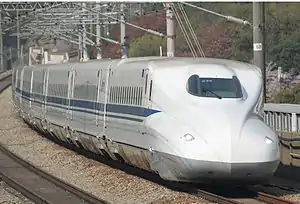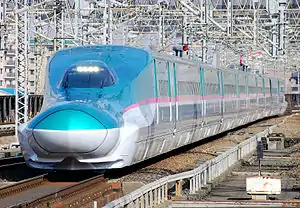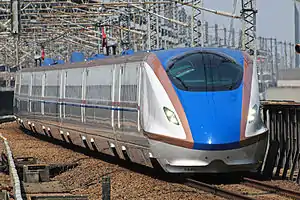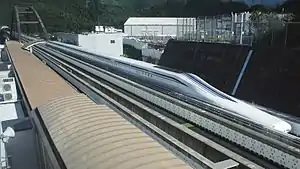Doctor Yellow
Doctor Yellow (ドクターイエロー) is the nickname for the high-speed test trains that are used on the Japanese Shinkansen ("Bullet Train") dedicated express passenger train routes. The trains have special equipment on board to monitor the condition of the track and overhead wire, including special instrumented bogies and observation blisters.[1]
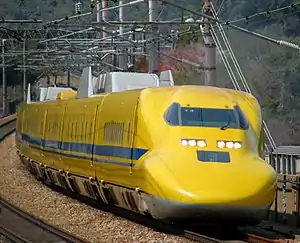
The "Doctor" part of the name is from their test and diagnostic function, and the "Yellow" part comes from the bright yellow color they are all painted. Some have a blue waistline stripe, some a green one. The original color scheme of yellow with a blue stripe (applied to the Class 921 track-recording cars) was created by reversing the colors (blue with yellow stripe) used on 1,067 mm (3 ft 6 in) narrow-gauge track-recording cars.
In build and appearance, they are very similar to production, passenger carrying Shinkansen trains, and line inspection is carried out at full line speed (i.e. up to 270 km/h or 168 mph on the Tōkaidō Shinkansen).
Legend has it that if one sees this train, the person who saw the train will have good fortune.
List of Doctor Yellow trains past and present
For Tōkaidō and Sanyō Shinkansen
- Non-powered track recording cars (Yellow with blue stripe):
- 921-1: Built in 1962 (initially numbered 4001), and withdrawn in 1980.
- 921-2: Converted in 1964 from former MaRoNeFu 29-11 sleeping car, and withdrawn in 1976.
- 0 series type (Yellow with blue stripe):
- 922-0 (Set T1): 4-car set converted in 1964 from the prototype set (class 1000 Set B) built in 1961, and withdrawn in 1976.
- 922-10 (Set T2): 7-car set owned by JR Central. Built in 1974 and withdrawn in 2001.
- 922-20 (Set T3): 7-car set owned by JR West. Built in 1979 and withdrawn in 2005.
- 700 series type (Yellow with blue stripe):
- 923 (Set T4): 7-car set owned by JR Central. Delivered in 2000.
- 923-3000 (Set T5): 7-car set owned by JR West. Delivered in 2005.
 JR Central Class 922 set T2, October 1998
JR Central Class 922 set T2, October 1998 JR West Class 922 set T3, October 2004
JR West Class 922 set T3, October 2004 JR Central Class 923 set T4, July 2008
JR Central Class 923 set T4, July 2008 JR West Class 923 set T5, July 2008
JR West Class 923 set T5, July 2008
For Tōhoku, Jōetsu, Hokuriku, Yamagata, and Akita Shinkansen
- 200 series type (Yellow with green stripe):
- E3 series type (White with red stripe)
- E926 (Set S51): "East i" 6-car set owned by JR East. Delivered in August 2001.
 Class 925 set S1, 1987
Class 925 set S1, 1987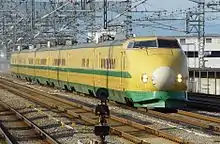 Class 925-10 set S2, September 2002
Class 925-10 set S2, September 2002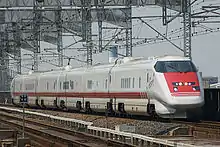 E926 East i train at Omiya Station, May 2001
E926 East i train at Omiya Station, May 2001
Interior (Class 923)[2]
 Interior of car number 1 used to inspect signalling, communications and power
Interior of car number 1 used to inspect signalling, communications and power Interior of car number 2 used to measure electricity
Interior of car number 2 used to measure electricity Observation window in car number 3
Observation window in car number 3 Seats in car number 5
Seats in car number 5 A meeting table in car number 6
A meeting table in car number 6
Preserved examples
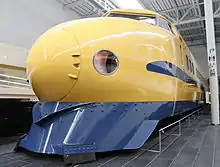
- 922-26 (ex-set T3, built 1979 by Hitachi) at SCMaglev and Railway Park, Nagoya, since March 2011[3]
In popular culture
Seeing as the schedule for this train is not made public, sighting is based purely on luck. It is therefore considered to bring good luck to anyone fortunate enough see it in operation.[4]
See also
- Comprehensive Inspection Train, used to evaluate the condition of the China Railway High-speed network.
- New Measurement Train, the British equivalent of Doctor Yellow, used to assess the condition of track
- TGV Iris 320, the French counterpart of Doctor Yellow, used to monitor the condition of the French tracks (mainly the high-speed railways LGV) used by high-speed trains.
References
- Wada, Shigeki, "'Dr. Yellow' train keeps line safe, elates spotters", Japan Times, March 11, 2010, p. 3.
- "Multipurpose Inspection Train (Dr. Yellow)" (PDF). International High-speed Rail Association.
- "「リニア・鉄道館」ファーストガイド" ["SCMaglev and Railway Park" First Guide]. Tetsudō Daiya Jōhō Magazine. Vol. 40 no. 324. Japan: Kōtsū Shimbun. April 2011. pp. 20–33.
- "'Dr. Yellow' lucky Shinkansen shows its belly for 1st time". Japan Bullet. Retrieved 2020-10-14.
External links
| Wikimedia Commons has media related to Doctor Yellow. |
| Wikimedia Commons has media related to Shinkansen E926. |
